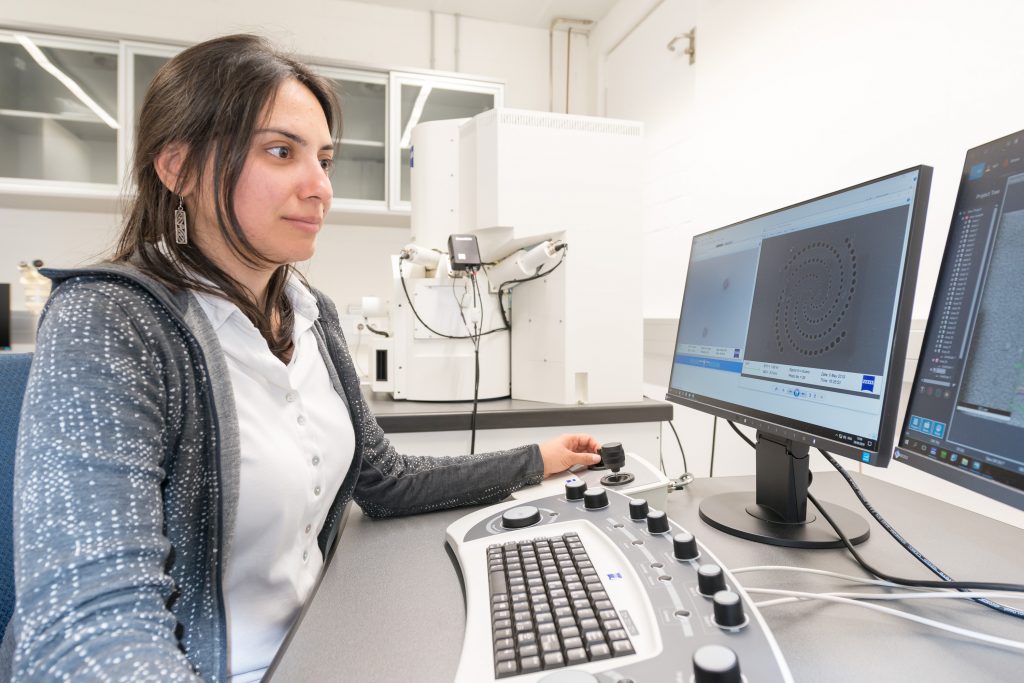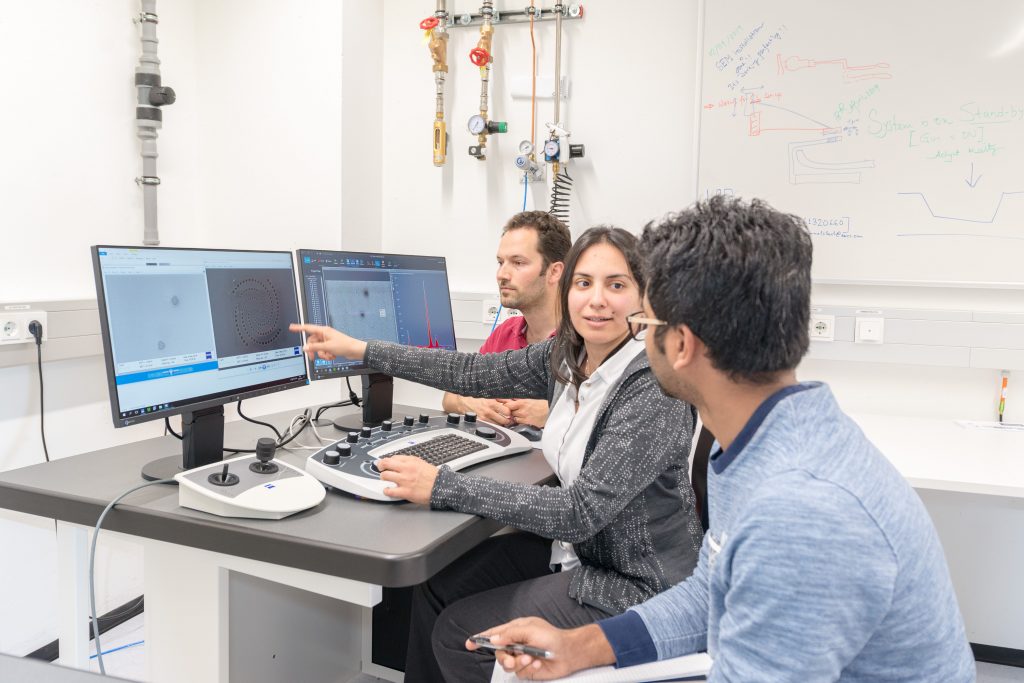Interview with Dr. Nahid Talebi, Max Planck Institute for Solid State Research
Why are there fewer women than men in science? Women are under-represented in scientific research, being only a third of researchers globally. Despite the progress in gender equality during the last decades, advances have been slow and there are still disparities around the world. Q-SORT is initiating a series of interviews with female researchers to find out more about their experiences. We begin with Nahid Talebi, who works as group leader at the Max Planck Institute for Solid State Research in Stuttgart. Her research focuses on investigating near-field-enhanced electron-photon interactions using slow and fast electron microscopes.

What is your specific area of research?
I am a physicist and focused on ultrafast electrodynamics. This is a specific area of science which deals with the interaction of ultrashort light pulses with free-electrons in vacuum and conduction/valence electrons at nanoscale dimensions in matter. In our studies, we are interested in understanding the dynamics of electron-light-matter interactions by probing the excitations in time-energy and space-momentum spaces. In other words, we use time-resolved spectroscopy and space-resolved diffraction techniques and additionally use electron microscopes for these purposes. Our mission is to understand and control charge- and energy-transfer dynamics in nanoscale materials. We are as well interested to understand the quantum mechanical behavior such as generating entangled electronic and photonic states and to understand the quantum phase evolution in interaction of free-electrons with light.
How would you explain your research field to young children?
Atoms are building blocks of all materials. Within these atoms we have though subatomic individual particles as well: electrons, protons, and neutrons. What determines the unique behavior of each material is how these electrons speak with each other and with other subatomic particles in materials. We are interested to understand and control the behavior of electrons in materials at dimensions a thousand times smaller than the thickness of a human hair: that is about 5 to 100 nanometers (1 nanometer = 1/100.000.000 of a meter). Other interesting aspects of electrons are that they are lighter than other subatomic particles, and therefore they move particularly faster than other particles – at time scales a 10 quadrillion (10.000.000.000.000) times faster than an eye blink!
What traits might a child possess that may indicate an interest or aptitude for your research field?
Curiosity about how natural laws work and how one can understand the behavior of nature in general, at dimensions as small as atoms and as large as the entire universe is what we consider as the science of nature; i.e., physics. However, we do not question why these laws exist: this is philosophy. A keen young investigator in electrodynamics is interested for example in the behavior of waves and fields: Wave is about the propagation of information and energy from a part of “something” to the other parts. This something can be a small rod, a pool full of water, or the universe! Fields describe the interactions between individual things positioned at certain distances from each other. Fields can be gravitational; they describe how planets orbit around massive stars. They can be also electrical: then they tell us how electrons orbit around protons and neutrons in atoms. You see here the beautiful similarities and patterns in the world surrounding you; a keen young investigator would like to better grasp the laws of physics. My son for example was interested to understand how one can make an image of the Higgs bosons at CERN; and why electron microscopes produce images that are black and white, while we see the world surrounding us in colors!
What did you know about your field when you were a child?
At the age of 10 to 12, I wanted to become an archeologist. I was interested particularly in the ancient history of Middle East. When I was only 13 or 14, my passion was mathematics. I was finding myself hours and hours playing with mathematics and trying to propose new problems for myself to solve them. My interests particularly were algebra and geometry. Physics came later to my life, at the age of about 16 to 18. At those times, we started classical and quantum mechanics and later on also electromagnetics. I loved it so much to see how we can model natural laws with simple mathematical formulas, were the solutions to those equations were harder than the formula itself! I also liked the concept of particles and waves. Later on at university, I wanted to choose a field which I was suited to both my talents in mathematics and physics. I chose electrical engineering with the mission to study fields and waves at higher education levels (a branch of telecommunications), and finally graduated from the Electrical Engineering Department with a minor in Physics.
Why did you choose your research field? Were you inspired by someone?
Actually, I was not inspired by a person, but by nature itself. I even remember that I was sent two times outside of the physics classroom in my high school because my physics teacher thought that I was not listening. It was partly true, because I was dreaming a lot and my mind was always full of imagination. I had and have the habit to concentrate fully on my own things, sometimes when topics were becoming boring and repetitive; I was then focusing on my own interests in physics.
What are some really cool things that people in your profession work on?
Currently people are interested in shaping the electron wavepackets as waves, and to understand the interaction of shaped electron wavepackets with light and matter. Both amplitude and phase of the electron pulses can be controlled, whereas the latter does not have any classical analog – it is purely a quantum mechanical phenomenon. This is also the particular topic that the Q-SORT meeting is focusing on. The second exciting topic is electronic and optical excitations in two-dimensional materials such as graphene or topological insulators. These materials can have excitations which are confined to the surfaces, as well as those excited in the bulk. Interestingly, DC transport and higher energy electrodynamics behavior such as axion electrodynamics can be studied in these materials. The third topic that I like very much is more an engineering concept that has very interesting applications: metamaterials. These are artificial materials that are engineered to behave in the artificial fashion that we want, but one cannot find natural analogs for them. This topic in general has been initiated by Sir John Pendry at Imperial College London and nowadays, nanofabrication techniques have advanced to the scale to realize 2D and 3D metamaterials of arbitrary accuracy, as is for example done in the group of Harald Giessen in Stuttgart. Metamaterials have applications in tailoring the polarization and propagation of light, but a combination of them with light might be used for particles such as electrons as well as to develop dynamics electron-optics counterparts. My research activities are also situated within these directions.

Do you have an analogy to help our readers to understand your work?
Although science is currently often about breaking symmetry, still the first conception comes from looking at symmetries and symmetric patterns. The way that we understand interferences for example is by looking at the developments of beautiful symmetric patterns in mechanical and electromagnetic waves. Mechanical waves might be better grasped by looking at the propagation of wave patterns in water for example. Solitons, which preserve a long lasting shape path for propagating waves, have been first observed in August 1834 by John Scott Russell when water waves travelled along a Scottish canal. Later, they were discovered in optical fibers which help to transfer electromagnetic information over kilometer-long distances. At the NanoMeta 2019 Conference in Seefeld, Mathias Fink provided another marvelous analogy between matter waves and electromagnetic waves by controlling the temporal response of water in a pool, to break the time-energy symmetry of waves and to control the direction of water and optical waves.

Is there a story/anecdote about your work that you would like to share with us?
During my PhD and the first years of my postdoc phase, when I had the Alexander von Humboldt Fellowship, I was focused particularly on my life as a scientist and as a mother, and enjoyed doing real science. Particular hardship came after that, when I had to decide with my family whether I should continue science or not – as I did not have a permanent position, and did not have the perspective of where to go. Mobility in science has turned into a must-for-success fact and this is not easy when you have a family. For a particular time in my life I decided to quit science and let my son continue growing up in Stuttgart, where he feels like home and has settled down from the time he was just three years old. I however became completely depressed when I was even thinking about my decision. My habilitation mentor, Prof. Harald Giessen, however, kindly convinced me to continue my path in science and pushed me to consider professorship applications. I am very lucky to have a marvelous family as well. When only after three applications I got a wonderful offer from the Christian-Albrechts-University in Kiel (Germany), my family was the first to open my letter, and in the evening they surprised me with a bunch of flowers! One should just follow his/her passion in life. Other things will finally work out.
How does your life as a top scientist compare with your expectations of it when you enrolled in Physics?
Currently, I should say it is more exciting! As a child, I was dreaming of a scientist as an isolated person in his/her room or laboratory, deeply focused on reading and writing, and also sometimes teaching. Now I see I should travel a lot and meet many other people in my field. The real learning is achieved by fruitful discussions with other scientists and collaborations, not an isolated life!
What are you currently working on and what is your long-term research goal?
I am working on developing a quantum-mechanical and self-consistent numerical framework for simulating the interaction of electron pulses with light and matter, within time-dependent Hartree-Fock theory. I am interested to develop this analysis for including higher-order perturbation terms in the quantum-field theory and move towards a full quantum-mechanical basis for understanding the relations between behaviors of materials in microscopic and macroscopic scales. I am also carrying out exciting experiments at the border between electron optics, electron microscopy, plasmonics, and ultrafast optics.
Why is your research important?
Physics and in particular the science of light, with electrodynamics at its heart, has been one of the most important fields of research that revolutionized the world in recent decades. Beginning with the invention of lasers, and later on ultrafast science, scientists have succeeded in not only improving their fundamental understandings of physical laws, but also bringing important applications like laser-based control of chemical reactions, medical applications such as eye surgery, quantum computing, and biological and gas sensors. However, a scientist’s mind in general should not be triggered by the applications of her/his research, but as to what basis one enjoys fundamental understandings and new discoveries. Such fundamental basis anyway renders itself in wonderful applications consequently.
Is there enough support/funding for science in Europe today? What could be improved in this respect, at a national and European level?
In general the European Research Council has greatly improved the situation of funding, in particular regarding fundamental science and concerning young ambitious scientists. Other national resources do exist on a great basis as well, particularly in Germany, ranging from scholarships to highly competitive support such as BMBF, DFG, Volkswagenstiftung, and Alexander von Humboldt Foundation, to name only a few. However, the support for young group leaders is particularly restricted to only few options in my opinion, and is very much dependent on the topics.
Are there still gender differences in your research environment and what are current opportunities and challenges for women in science?
Gender differences still do exist and as a matter of fact, physics particularly has one of the worst reputations considering this issue. According to a report from Physics World on diversity and Inclusion, with the title “Gender Gap in Physics Amongst Highest in Science,” only 13% of last authors in physics from 1991 to 2018 were women. This still does not determine the number of female professors in physics, and does not tell about the number of those who have children.
Some people still think that women are less capable of men in science, even within the scientific community itself (https://en.wikipedia.org/wiki/Alessandro_Strumia). Of course, when tracing the progress of male and female physicists in their studies during the school and later on at the universities, this can be obviously not correct. The matter of the fact that the developments in career steps and the ability to move to upper classes in hierarchy is less obvious for women is likely due to the cultural basis of the research environment and society in general. Planning strategies to improve this situation in my opinion should try to correct the cultural basis and to help dual-career families, encouraging men to take care of the family at the same footing as women, and teaching women to be as highly ambitious as their male colleagues in science. Career is not all about talent, but also about ambition, and about the ability to confront frustrations. In addition, society should become more tolerant towards working female scientists with children, who as scientists have the mind full of imaginations and creativity. It is not only about working hours, since a scientist’s mind usually does not even recognize nonworking hours! This in turn will put some pressure on the family with a physicist mother, and in general will cause an imbalance in the society as well, between families with and without scientist mothers.
What inspirational message would you give young girls to inspire them to pursue a career in science?
Your talents are there to flourish for the sake of science, to be enjoyed by yourself, and being employed in the favor of society as well. There exists no barrier that you cannot break – just some self-confidence, tolerance, mastering your time schedule, and that is all! Living a full life is to enjoy all your talents, as a scientist, as a mother, and as a compassionate female member of the scientific society. My most wonderful friendships have been developed during my scientific career path with those having the same passionate goals and ambitions as myself.

